Throwback Thursday: December 16, 2021
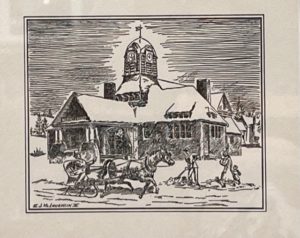
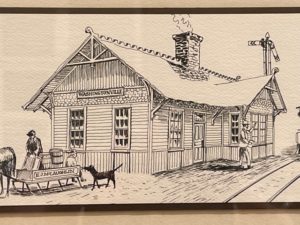
This week we are highlighting these iconic greeting cards created by local artist and historian Edward J. McLaughlin III. Edward J. McLaughlin received his Bachelors in graphic design from Pratt institute before serving in the Army Air Corps from 1942 to 1945. However, McLaughlin’s career as a professional illustrator began when he was still a student at Pratt, and published his first illustration as a cartoonist and correspondent for the Orange County Post in on June 7, 1938. His work would extend to illustrating books such as The History of Connecticut Railroads and The Hudson, both by Carl Cramer.
McLaughlin’s connection to several local families; including the Burnetts, Boards, and Clintons, as well as his family’s role in the development of Washingtonville helped inspire his passion for history. In 1987 he published his first book The Library and Empire of David H. Moffat, and followed it up with Around the Watering Trough: A History of Washingtonville, N.Y. in 1994. He also worked to install the historic markers located throughout Washingtonville; notably the site of the Erie Railroad Station, and Brooks’ Bridge. Although he passed away on April 20th, 1995, his legacy as an artist and a passionate historian lived on through the many illustrations of life in Washingtonville at the turn of the 20th century.
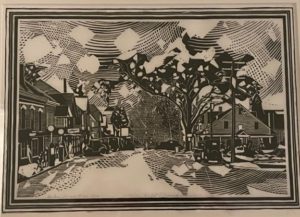
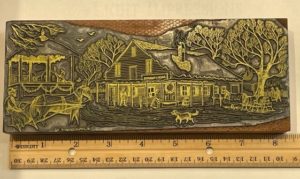
Using his own memories of growing up in the village, as well as those of his contemporaries, McLaughlin drew scenes of landmarks such as the Moffat Library, the village square, and the Erie Depot. These images were reproduced on placemats, greeting cards, and framed prints using a technique known as “intaglio printing”. Unlike relief printing, where an image is created from the raised edges of a plate, an intaglio print is produced by carving an image onto a copper plate in relief. The plate is then coated in ink, which runs into the grooves of the copper plate. The plate is then pressed onto the printing surface using a rollerpress, the large amount of force results in the ink to penetrate the surface from the inside grooves of the plate. Intaglio printing also allows for multiple colors to be printed on a single image. This could either be done by dabbing different colors on different areas of a plate with a doll-shaped bundle of fabric, known as à la poupée, French for “with the doll”, or using separate plates with different colors and precisely printing in specific areas of the image. These multi-colored printing techniques were probably how some of McLaughlin’s images have colored backgrounds or accents.
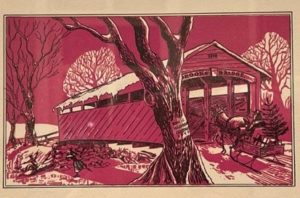
The work of E.J. McLaughlin III holds a nostalgic place in the hearts of those who either received one of his holiday cards, or purchased a print from him. The Moffat Library is fortunate enough to have many of his prints on display, as well as the copper plates used to produce these works of art! To experience them up close, E.J.’s work is on permanent view in our Adult, and Local History rooms.
Bibliography
Ballou, Nancy. “This History of Intaglio.” This history of intaglio. Copper Development Association Inc., January 2012. https://www.copper.org/consumers/arts/2012/january/This_History_of_Inta.html.
Britannica, T. Editors of Encyclopaedia. “intaglio.” Encyclopedia Britannica, Invalid Date. https://www.britannica.com/topic/intaglio-printing.
McLaughlin III, E. J. (1994). Around the Watering Trough: A History of Washingtonville, N.Y. Washingtonville Centennial Celbration, Inc.

